
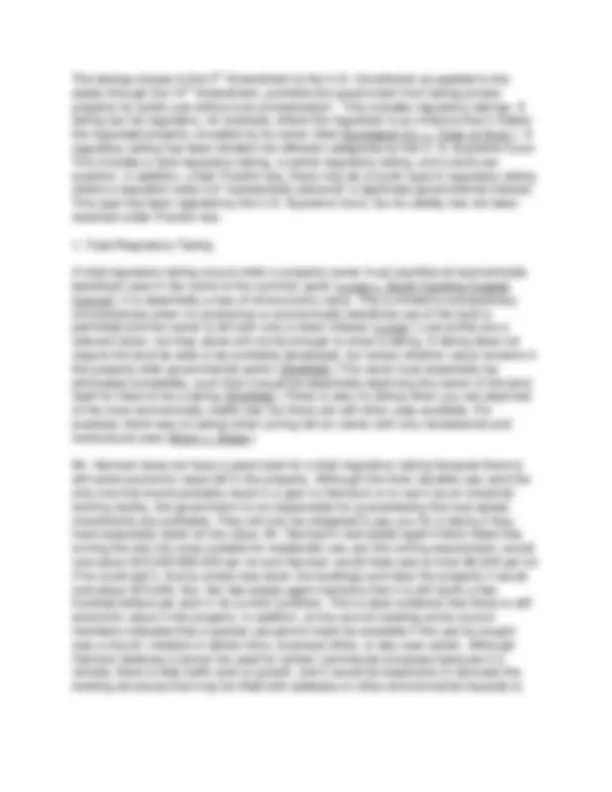
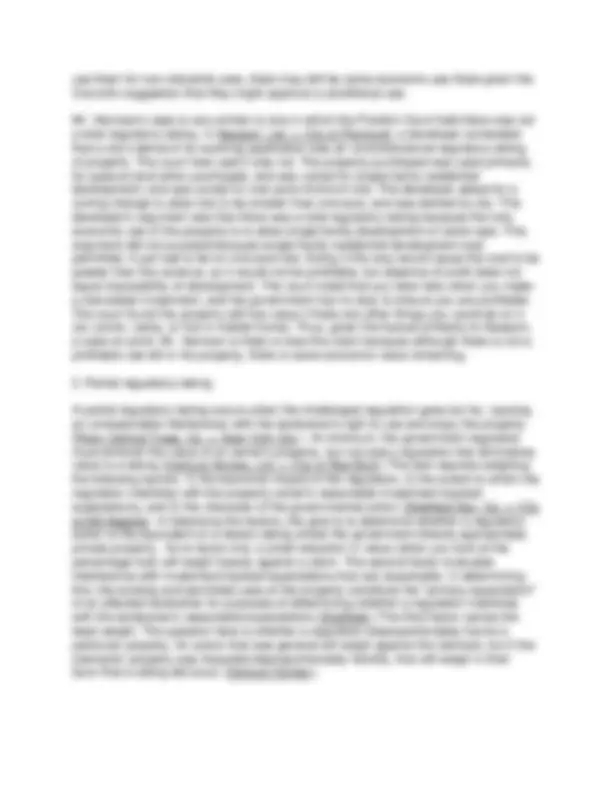
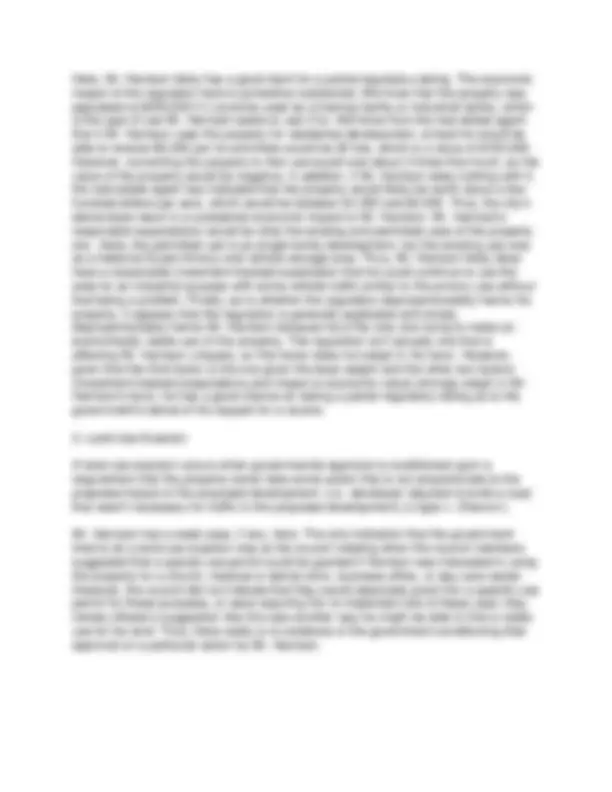
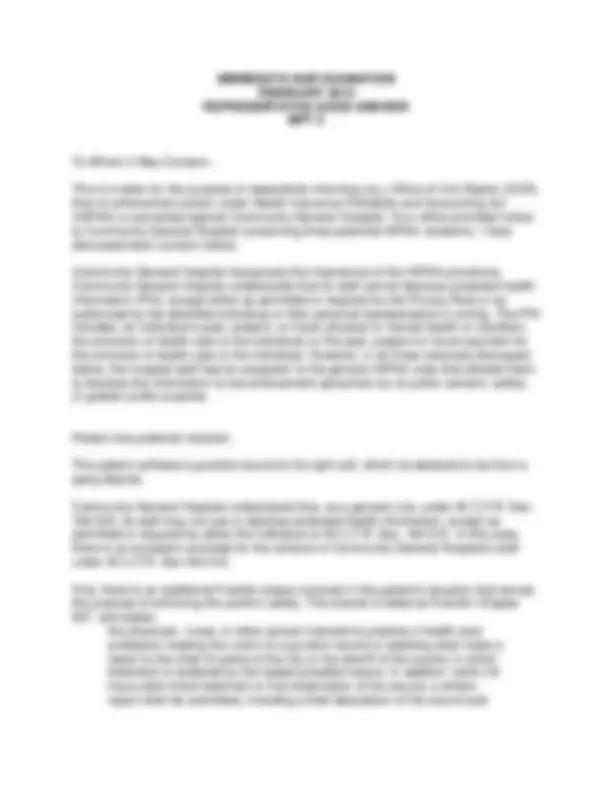
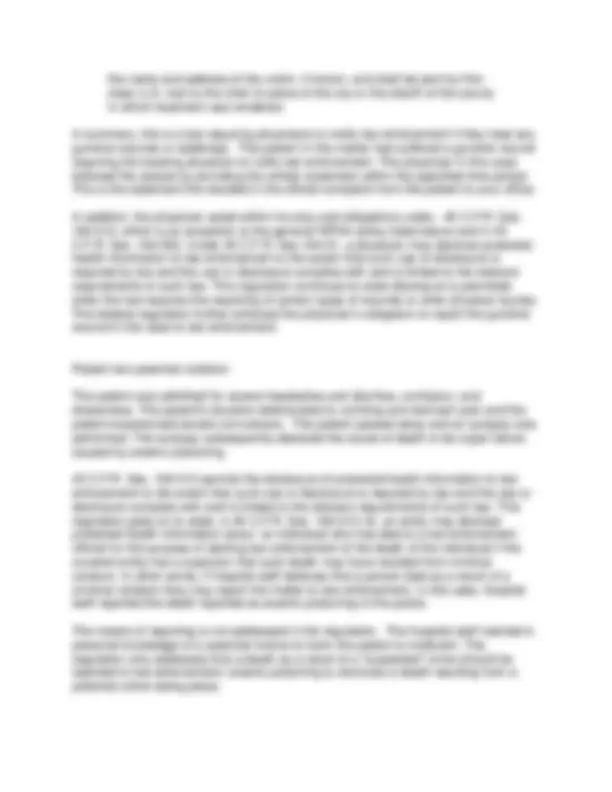
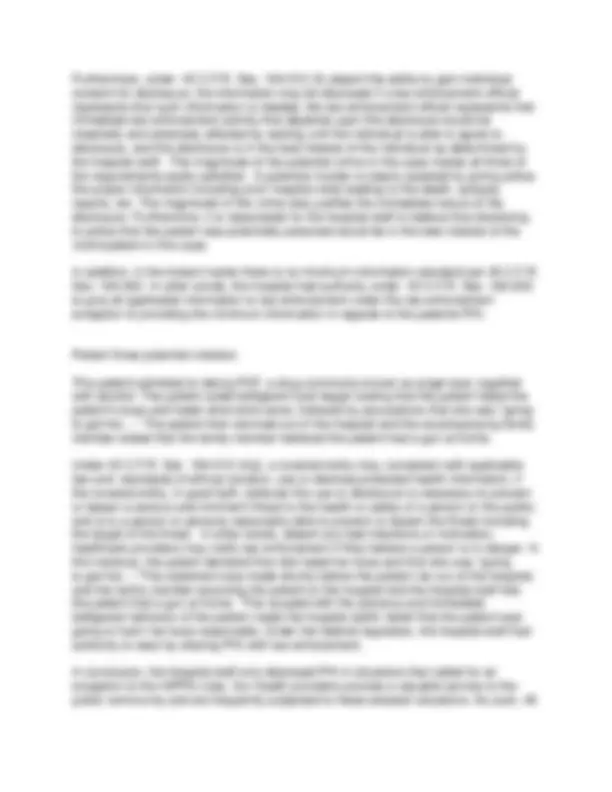

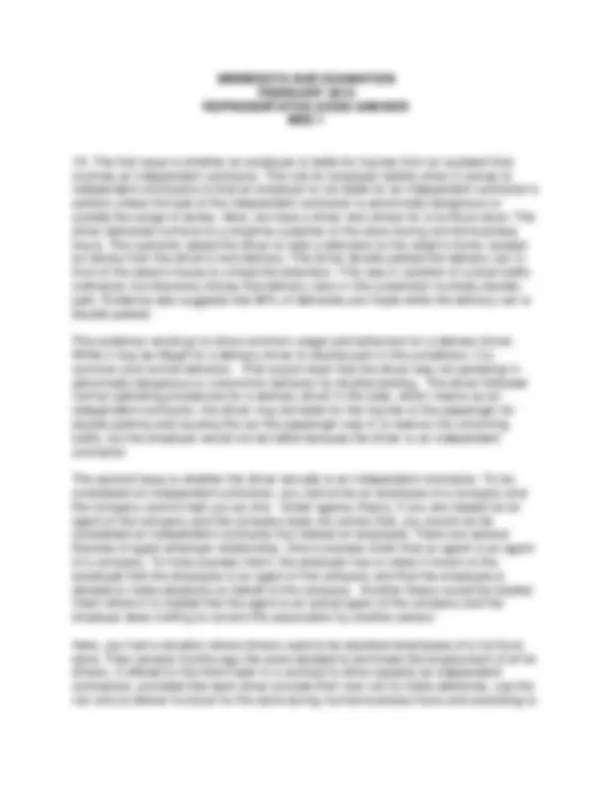
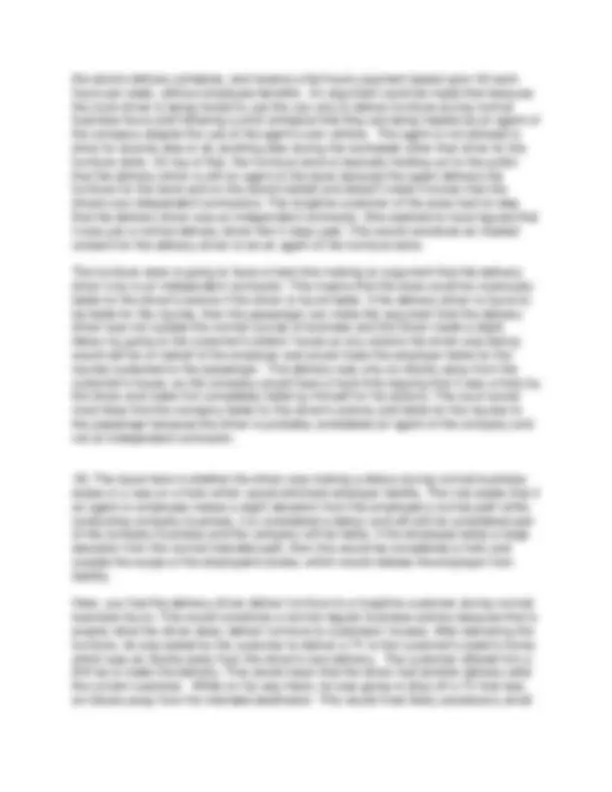
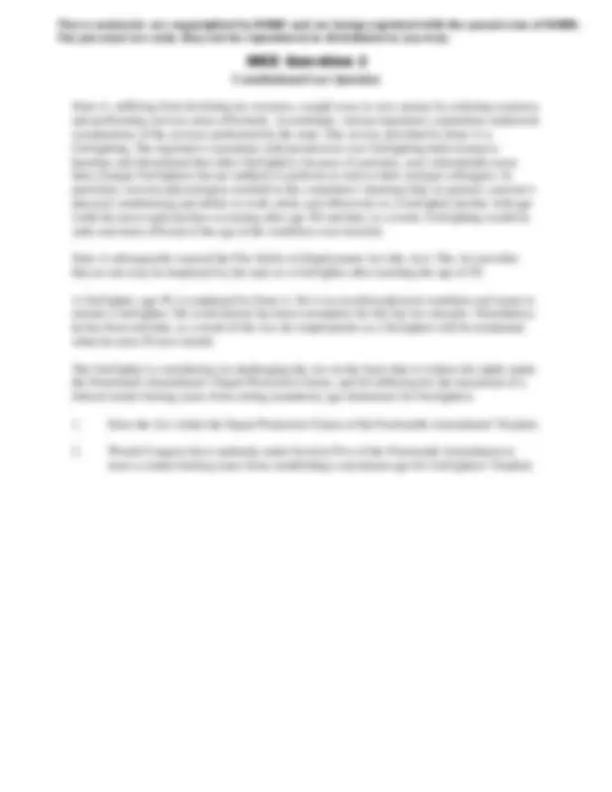
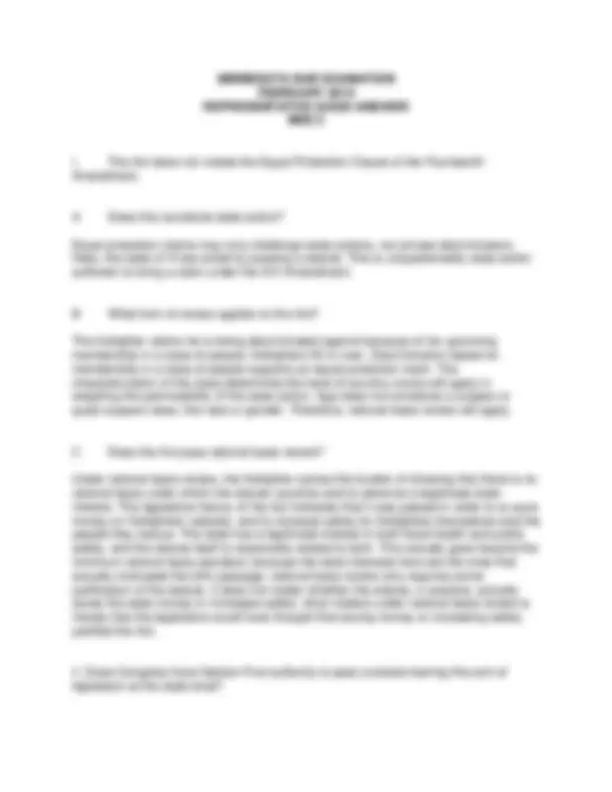

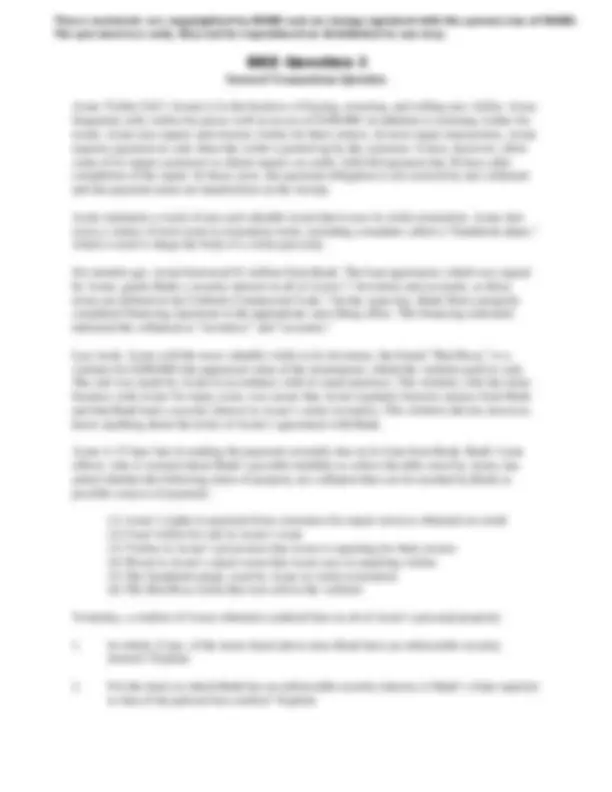
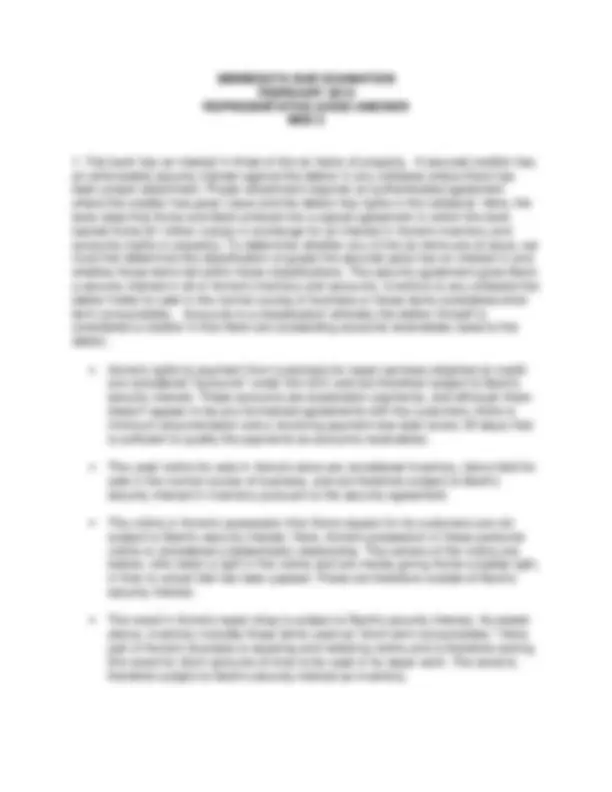

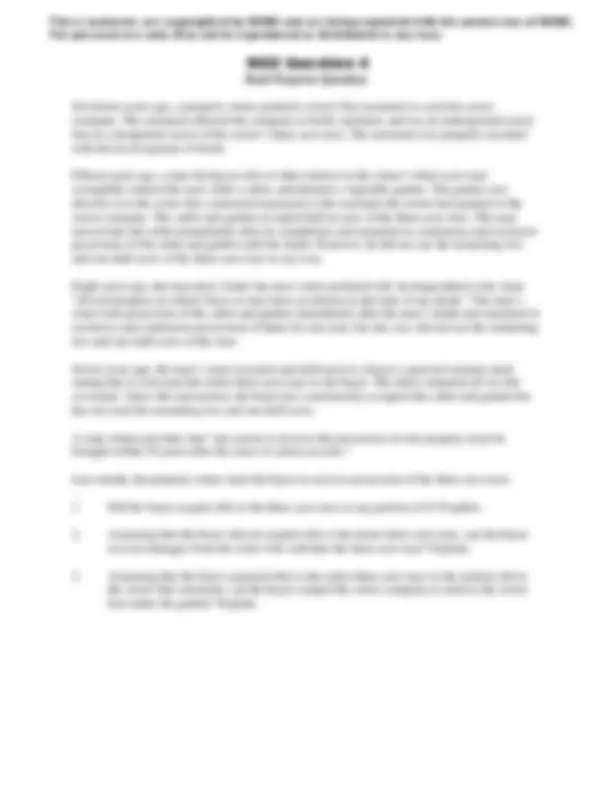
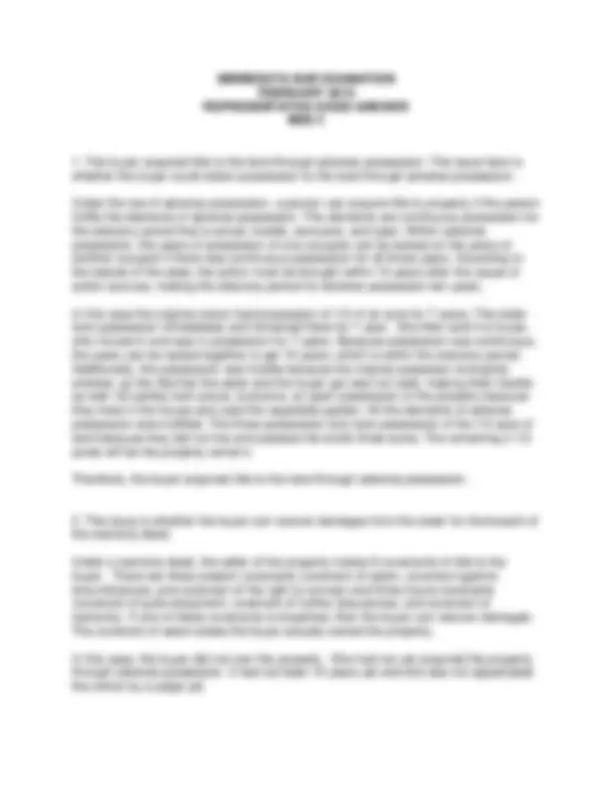

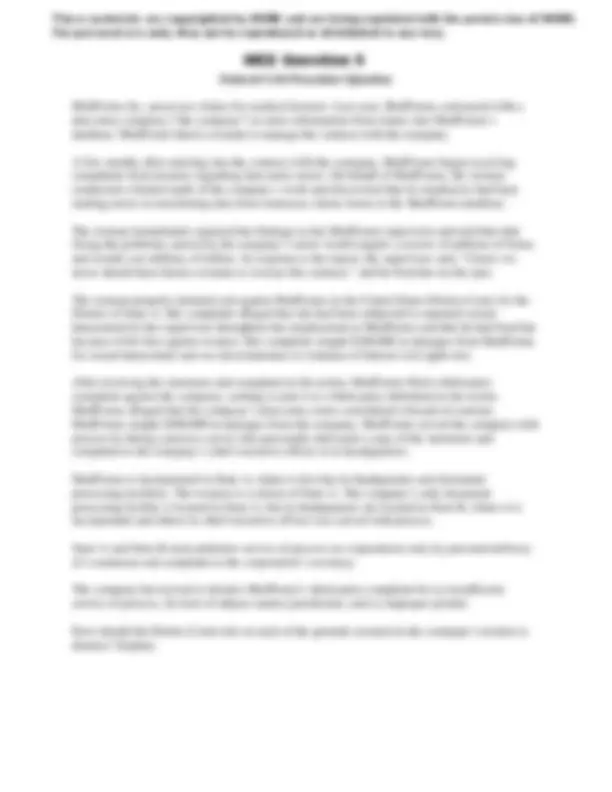
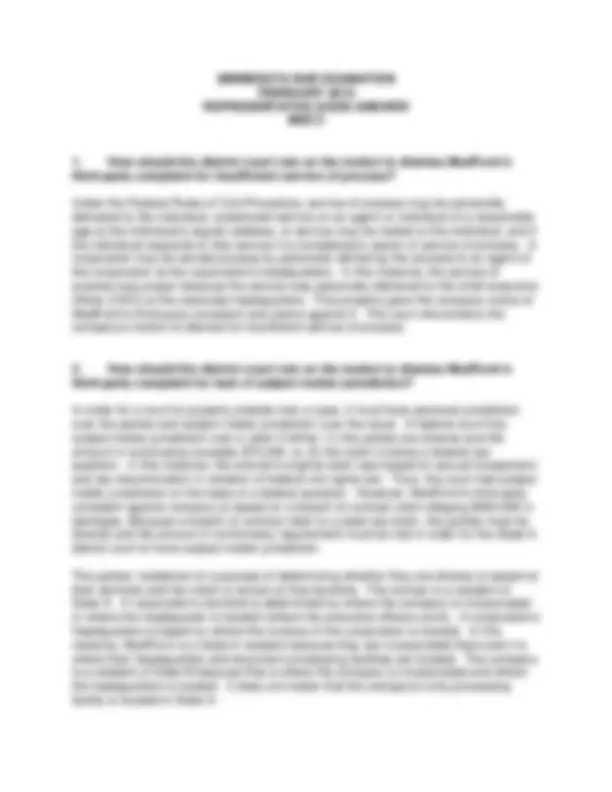
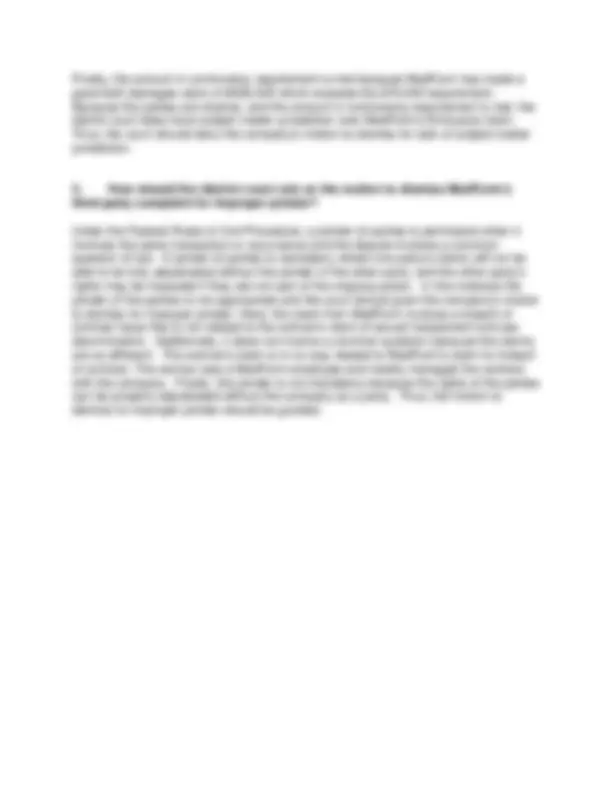
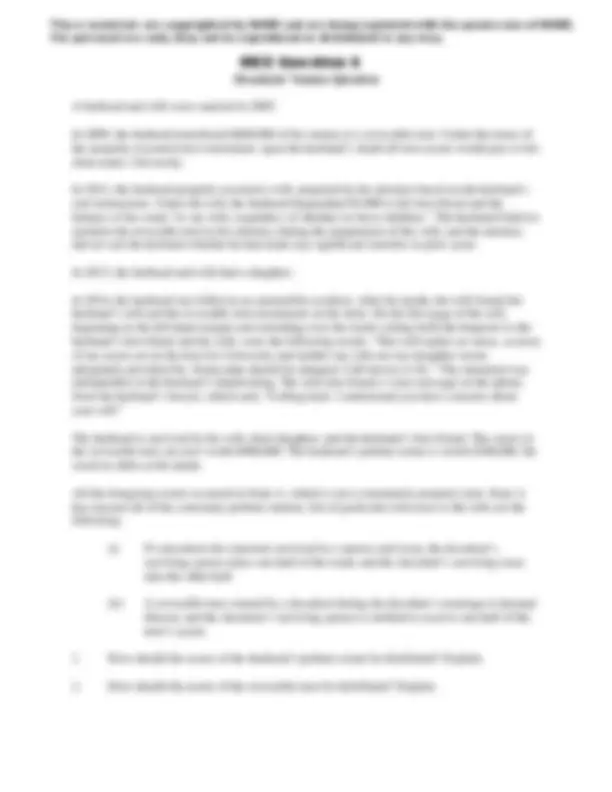
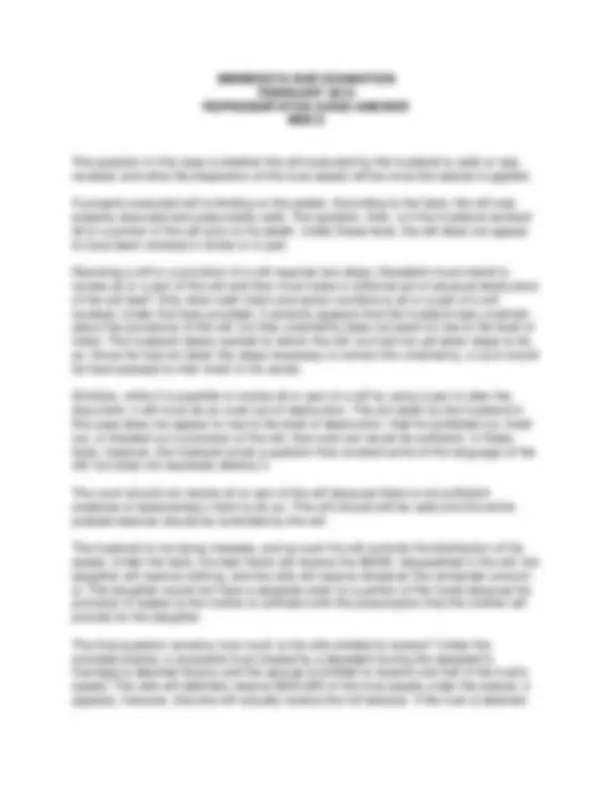



Study with the several resources on Docsity

Earn points by helping other students or get them with a premium plan


Prepare for your exams
Study with the several resources on Docsity

Earn points to download
Earn points by helping other students or get them with a premium plan
Community
Ask the community for help and clear up your study doubts
Discover the best universities in your country according to Docsity users
Free resources
Download our free guides on studying techniques, anxiety management strategies, and thesis advice from Docsity tutors
An analysis of the inverse condemnation theories available under Franklin and federal law, and whether Daniel Harrison might succeed in an inverse condemnation action against the City of Abbeville for zoning his property. The document also discusses the applicability of HIPAA regulations in the context of a hospital reporting a gunshot wound to law enforcement.
Typology: Schemes and Mind Maps
1 / 32

This page cannot be seen from the preview
Don't miss anything!

























In re Harrison (MPT-1) In this performance test item, examinees are associates at a law firm representing Daniel Harrison, who has purchased a tract of land in the City of Abbeville, Franklin. Although the land is currently zoned “R–1” (single-family residential), it had been used for over 35 years as a National Guard armory and vehicle storage facility; when he purchased the land, Harrison assumed that it was “grandfathered in” and not subject to the residential zoning ordinance because the National Guard’s use of the property predated the R–1 zoning change. Harrison wants to have the land rezoned so that it can be used as a commercial truck-driving school, but the City Council denied his rezoning application. Harrison seeks the firm’s advice as to whether he can successfully pursue an inverse condemnation action against the City. Examinees’ task is to draft an objective memorandum identifying each of the inverse condemnation theories available under Franklin and federal law and analyzing whether Harrison might succeed against the City under each of those theories. The File contains the instructional memorandum from the supervising attorney, a summary of the client interview, a recent appraisal of the tract, and an email exchange between Harrison and a real estate agent. The Library contains the Franklin and federal constitutional “takings” clauses and two Franklin cases that discuss various regulatory takings theories.
To: Esther Barbour
From: Examinee
Re: Daniel Harrison Date: 2/24/
Memorandum
You have asked me to identify the inverse condemnation theories available under Franklin and federal law, and whether our client, Mr. Daniel Harrison, might succeed in an inverse condemnation action against the city of Abbeville (City) under each of the theories. The issue for determination is whether the City’s actions amount to a taking in zoning the property that Mr. Harrison bought to single-family residential development and denying his application to rezone the property.
Inverse Condemnation occurs when the government takes private property for public use without paying the property owner, and the property owner sues the government to recover compensation for the taking (Newpark Ltd. v. City of Plymouth). It is called inverse condemnation because the property owner here is the plaintiff, contrary to a direct condemnation action where the government is the plaintiff in an action seeking to take the landowner's property. There is both a federal constitutional provision, and a provision of the Franklin state constitution, that give rights to a person for an inverse condemnation action. The U.S. Constitutional provision is the Takings Clause of the 5th Amendment as applied to the state through the 14th^ Amendment. Franklin's state prohibition against taking without just compensation is in Article 1, Section 13 of the Franklin constitution. The Franklin provision is comparable to the takings clause of the U.S. Constitution, despite minor differences in wording. Therefore, the Franklin courts will use federal cases for guidance in applying the state takings clause (Franklin Sup. Ct. 2006).
There are 4 theories that could potentially be used by Mr. Harrison excluding physical takings, and I will discuss each below, along with an analysis of his potential success under these theories. However, it should be noted that if a plaintiff prevails in an inverse condemnation action, the remedy is that the city must pay you adequate compensation, but then the city will own the property (Newpark). So if Mr. Harrison is seeking to keep the property, an inverse condemnation action would not be appropriate, because it would not allow him to keep the property.
use them for non-industrial uses, there may still be some economic use there given the Council's suggestion that they might approve a conditional use.
Mr. Harrison's case is very similar to one in which the Franklin Court held there was not a total regulatory taking. In Newport Ltd. v. City of Plymouth, a developer contended that a city's denial of its rezoning application was an unconstitutional regulatory taking of property. The court here said it was not. The property purchased was used primarily for pasture land when purchased, and was zoned for single-family residential development, and was zoned for one-acre-minimum lots. The developer asked for a zoning change to allow lots to be smaller than one acre, and was denied by city. The developer’s argument was that there was a total regulatory taking because the only economic use of the property is to allow single-family development of some type. This argument did not succeed because single-family residential development was permitted, it just had to be on one-acre lots. Doing it this way would cause the cost to be greater than the revenue, so it would not be profitable, but absence of profit does not equal impossibility of development. The court noted that you take risks when you make a real estate investment, and the government has no duty to ensure you are profitable. The court found the property still has value if there are other things you could do on it (ex: picnic, camp, or live in mobile home). Thus, given the factual similarity to Newport, a case on point, Mr. Harrison is likely to lose this claim because although there is not a profitable use left in his property, there is some economic value remaining.
A partial regulatory taking occurs when the challenged regulation goes too far, causing an unreasonable interference with the landowner's right to use and enjoy the property (Penn Central Trasp. Co. v. New York City.) At minimum, the government regulation must diminish the value of an owner's property, but not every regulation that diminishes value is a taking (Venture Homes, Ltd. v. City of Red Bluff.) The test requires weighing the following factors: 1) the economic impact of the regulation, 2) the extent to which the regulation interferes with the property owner's reasonable investment-backed expectations, and 3) the character of the governmental action (Sheffield Dev. Co. v. City of Hill Heights). In balancing the factors, the goal is to determine whether a regulatory action is the equivalent of a classic taking where the government directly appropriates private property. As to factor one, a small reduction in value (when you look at the percentage lost) will weigh heavily against a claim. The second factor evaluates interference with investment-backed expectations that are reasonable. In determining this, the existing and permitted uses of the property constitute the "primary expectation" of an affected landowner for purposes of determining whether a regulation interferes with the landowner's reasonable expectations (Sheffield.) The third factor carries the least weight. The question here is whether a regulation disproportionately harms a particular property. An action that was general will weigh against the claimant, but if the claimants’ property was impacted disproportionately harshly, that will weigh in their favor that a taking did occur (Venture Homes.)
Here, Mr. Harrison likely has a good claim for a partial regulatory taking. The economic impact of the regulation here is somewhat substantial. We know that the property was appraised at $200,000 if it could be used as a training facility or industrial facility, which is the type of use Mr. Harrison seeks to use it for. We know from the real estate agent that if Mr. Harrison uses the property for residential development, at best he would be able to receive $5,000 per lot and there would be 30 lots, which is a value of $150,000. However, converting the property to that use would cost about 3 times that much, so the value of the property would be negative. In addition, if Mr. Harrison does nothing with it, the real estate agent has indicated that the property would likely be worth about a few hundred dollars per acre, which would be between $1,000 and $2,000. Thus, the city’s denial does result in a substantial economic impact to Mr. Harrison. Mr. Harrison's reasonable expectations would be what the existing and permitted uses of the property are. Here, the permitted use is as single-family development, but the existing use was as a National Guard Armory and vehicle storage area. Thus, Mr. Harrison likely does have a reasonable investment-backed expectation that he could continue to use the area for an industrial purpose with some vehicle traffic similar to the armory use without that being a problem. Finally, as to whether the regulation disproportionately harms his property, it appears that the regulation is generally applicable and simply disproportionately harms Mr. Harrison because he is the only one trying to make an economically viable use of this property. The regulation isn't actually one that is affecting Mr. Harrison uniquely, so this factor does not weigh in his favor. However, given that the third factor is the one given the least weight and the other two factors (investment-backed expectations and impact to economic value) strongly weigh in Mr. Harrison's favor, he has a good chance at raising a partial regulatory taking as to the government's denial of his request for a rezone.
A land-use exaction occurs when governmental approval is conditioned upon a requirement that the property owner take some action that is not proportionate to the projected impact of the proposed development (i.e.: developer required to build a road that wasn't necessary for traffic to the proposed development) ( Lingle v. Chevron .)
Mr. Harrison has a weak case, if any, here. The only indication that the government tried to do a land-use exaction was at the council meeting when the council members suggested that a special use permit could be granted if Harrison was interested in using the property for a church, medical or dental clinic, business office, or day-care center. However, the council did not indicate that they would absolutely grant him a specific use permit for these purposes, or were requiring him to implement one of these uses, they merely offered a suggestion that this was another way he might be able to find a viable use for his land. Thus, there really is no evidence of the government conditioning their approval on a particular action by Mr. Harrison.
In re Community General Hospital (MPT-2) Examinees’ law firm represents Community General Hospital, which has received a letter from the Office of Civil Rights (OCR) of the U.S. Department of Health and Human Services. The letter from the OCR states that it has learned of three cases in which Community General disclosed protected health information without a written patient authorization as required by the federal Health Insurance Portability and Accountability Act (HIPAA) regulations. If Community General cannot justify the disclosures, the OCR will pursue an enforcement action against the hospital. Examinees’ task is to draft a letter responding to the OCR, parsing the HIPAA regulations and setting forth the argument that the disclosures fit specific exceptions to the general rule requiring a written authorization from a patient (or someone authorized to act on the patient’s behalf), and that therefore there has been no HIPAA violation by hospital personnel. The File contains the instructional memorandum, the letter from the OCR, a memorandum from the hospital’s medical records director discussing the three patients’ cases, a letter from a treating physician, a pathology report, and a memorandum from the supervising partner outlining the purpose and structure of the HIPAA regulations. The Library contains a Franklin state statute requiring health care professionals to report gunshot and stabbing wounds to law enforcement and excerpts from the HIPAA regulations [found at 45 C.F.R. §§ 164.502 and 164.512].
To Whom It May Concern,
This is a letter for the purpose of respectfully informing you, Office of Civil Rights (OCR), that no enforcement action under Health Insurance Portability and Accounting Act (HIPAA) is warranted against Community General Hospital. Your office provided notice to Community General Hospital concerning three potential HIPAA violations. I have discussed each concern below.
Community General Hospital recognizes the importance of the HIPAA provisions. Community General Hospital understands that its staff cannot disclose protected health information (PHI), except either as permitted or required by the Privacy Rule or as authorized by the identified individual or their personal representative in writing. The PHI includes: an individual’s past, present, or future physical or mental health or condition; the provision of health care to the individual; or the past, present or future payment for the provision of health care to the individual. However, in all three instances discussed below, the hospital staff had an exception to the general HIPAA rules that allowed them to disclose the information to law enforcement personnel out of public concern, safety, or greater public purpose.
Patient one potential violation:
This patient suffered a gunshot wound to his right calf, which he declared to be from a gang dispute.
Community General Hospital understands that, as a general rule, under 45 C.F.R. Sec. 164.502, its staff may not use or disclose protected health information, except as permitted or required by either the individual or 45 C.F.R. Sec. 164.512. In this case, there is an exception provided for the conduct of Community General Hospital's staff under 45 C.F.R. Sec.164.512.
First, there is an additional Franklin statue involved in this patient's situation that serves the purpose of enforcing the public's safety. This statute is listed as Franklin Chapter 607, and states: the physician, nurse, or other person licensed to practice a health care profession treating the victim of a gunshot wound or stabbing shall make a report to the chief of police of the city or the sheriff of the country in which treatment is rendered by the fastest possible means. In addition, within 24 hours after initial treatment or first observation of the wound, a written report shall be submitted, including a brief description of the wound and
Furthermore, under 45 C.F.R. Sec. 164.512 (3) absent the ability to gain individual consent for disclosure, the information may be disclosed if a law enforcement official represents that such information is needed, the law enforcement official represents that immediate law enforcement activity that depends upon the disclosure would be materially and adversely affected by waiting until the individual is able to agree to disclosure, and the disclosure is in the best interest of the individual as determined by the hospital staff. The magnitude of the potential crime in this case makes all three of the requirements easily satisfied. A potential murder is clearly assisted by giving police the proper information including prior hospital visits leading to the death, autopsy reports, etc. The magnitude of the crime also justifies the immediate nature of the disclosure. Furthermore, it is reasonable for the hospital staff to believe that disclosing to police that the patient was potentially poisoned would be in the best interest of the victim/patient in this case.
In addition, in the instant matter there is no minimum information standard per 45 C.F.R. Sec. 164.502. In other words, the hospital had authority under 45 C.F.R. Sec. 164. to give all applicable information to law enforcement under the law enforcement exception to providing the minimum information in regards to the patients PHI.
Patient three potential violation:
This patient admitted to taking PCP, a drug commonly known as angel dust, together with alcohol. The patient acted belligerent and began stating that the patient hated the patient’s boss and hated what she's done, followed by accusations that she was "going to get her...." The patient then stormed out of the hospital and the accompanying family member stated that the family member believed the patient had a gun at home.
Under 45 C.F.R. Sec 164.512 (4)(j), a covered entity may, consistent with applicable law and standards of ethical conduct, use or disclose protected health information, if the covered entity, in good faith, believes the use or disclosure is necessary to prevent or lessen a serious and imminent threat to the health or safety of a person or the public; and is to a person or persons reasonably able to prevent or lessen the threat including the target of the threat. In other words, absent any bad intentions or motivation, healthcare providers may notify law enforcement if they believe a person is in danger. In this instance, the patient declared that she hated her boss and that she was "going to get her..." This statement was made shortly before the patient ran out of the hospital, and the family member escorting the patient to the hospital told the hospital staff that the patient had a gun at home. This coupled with the previous and immediate belligerent behavior of the patient made the hospital staffs’ belief that the patient was going to harm her boss reasonable. Under the federal regulation, the hospital staff had authority to react by sharing PHI with law enforcement.
In conclusion, the hospital staff only disclosed PHI in situations that called for an exception to the HIPPA rules. Our health providers provide a valuable service to the public community and are frequently subjected to these stressful situations. As such, 45
C.F.R. Sec. 164.512 protects their acts on occasions such as those discussed above by providing statutory language that grants the healthcare provider a general presumption of good faith in their conduct. In other words, if the court or even our community was to question the healthcare providers, we would start by assuming their actions were performed in good faith, or under good intentions. In order for this presumption to apply, the healthcare provider must have actual knowledge or be acting in reliance on a credible representation by a person with apparent knowledge or authority. In all three cases, the healthcare provider had actual knowledge of the public concern, safety, or greater public purpose. As such, the presumption of good faith should be applied in all three of the above cases. In addition, in all three instances mentioned above, there is no minimum information standard per 45 C.F.R. Sec. 164.502. In other words, the hospital had authority under 45 C.F.R. Sec. 164.502 to give all applicable information to law enforcement under the law enforcement exception to providing the minimum information in regards to the patients PHI.
We hope that this letter has better informed you as to the situations that lead to the potential HIPAA violations and we subsequently request that you refrain in your discretion from enforcement action under Health Insurance Portability and Accounting Act (HIPAA) against Community General Hospital.
The store argues that it is not liable for the passenger’s injuries because (a) the driver is an independent contractor; (b) even if the driver is not an independent contractor, the driver was not making a delivery for the store when the accident occurred; and (c) the driver himself could not be found liable for the passenger’s injuries.
1A. The first issue is whether an employer is liable for injuries from an accident that involves an independent contractor. The rule for employer liability when it comes to independent contractors is that an employer is not liable for an independent contractor’s actions unless the task of the independent contractor is abnormally dangerous or outside the scope of duties. Here, we have a driver who drives for a furniture store. The driver delivered furniture to a longtime customer of the store during normal business hours. The customer asked the driver to take a television to her sister's home, located six blocks from the driver's next delivery. The driver double-parked the delivery van in front of the sister's house to unload the television. This was in violation of a local traffic ordinance, but discovery shows that delivery vans in this jurisdiction routinely double- park. Evidence also suggests that 80% of deliveries are made while the delivery van is double-parked.
This evidence would go to show common usage and behaviors for a delivery driver. While it may be illegal for a delivery driver to double-park in this jurisdiction, it is common and normal behavior. That would mean that the driver was not partaking in abnormally dangerous or uncommon behavior by double-parking. The driver followed normal operating procedures for a delivery driver in the area, which means as an independent contractor, the driver may be liable for the injuries to the passenger for double-parking and causing the car the passenger was in to swerve into oncoming traffic, but the employer would not be liable because the driver is an independent contractor.
The second issue is whether the driver actually is an independent contractor. To be considered an independent contractor, you cannot be an employee of a company and the company cannot treat you as one. Under agency theory, if you are treated as an agent of the company and the company does not correct that, you would not be considered an independent contractor but instead an employee. There are several theories of agent employer relationship. One is express intent that an agent is an agent of a company. To have express intent, the employer has to make it known to the employee that the employee is an agent of the company and that the employee is allowed to make decisions on behalf of the company. Another theory would be implied intent where it is implied that the agent is an actual agent of the company and the employer does nothing to correct this assumption by another person.
Here, you had a situation where drivers used to be standard employees of a furniture store. Then several months ago the store decided to terminate the employment of all its drivers. It offered to hire them back in a contract to drive capacity as independent contractors, provided that each driver provide their own van to make deliveries, use the van only to deliver furniture for the store during normal business hours and according to
detour from his intended route and activities. He is making a trip only six blocks from the intended location to deliver a TV. He is not driving all the way across town or in the opposite direction of his intended delivery or even several miles past. Six blocks is a rather short distance.
Since this is most likely going to be considered a detour during normal business activities, the employer would be held liable for the passenger's injuries. If the driver is only making a detour and not a frolic, it is still considered covered work activity for liability purposes. As discussed, six blocks is not enough to constitute a frolic so the delivery driver would be within his normal duties and the employer would hence be liable.
1C. The issue here is whether the driver is liable for the passenger's injuries. The rule here would be that of negligence. To have negligence you need a duty, breach, cause, and damages. The first thing we are concerned with is whether the delivery driver had a duty to the passenger of the vehicle. While delivering furniture, a delivery driver is going to have a duty to be safe and not cause any accidents. He also has a duty to maintain his truck in a safe manner so the truck does not cause any injuries. The delivery driver definitely had a duty here to the passenger to make sure his truck was not going to harm her in any way. The passenger of the vehicle could argue that the delivery driver breached his duty by double-parking it in front of the customer's house. Though this may be considered custom in the delivery industry and may happen 80% of the time, it would still be a breach of the driver's duty because he is making his truck more likely to cause an accident and hurt someone by double-parking and making it harder to get around. Accordingly, there is a duty and a breach of that duty by double- parking the delivery truck.
To have cause in fact, the cause needs to be the actual cause of the negligent action that breached a duty. Here, the delivery driver purposely double-parked his vehicle and the passenger vehicle swerved around it to avoid it and went into oncoming traffic and hit a garbage truck. Without the delivery truck double-parking, the passenger vehicle would not have had to swerve around it into oncoming traffic. This means it's the actual cause of the injuries to the passenger. You also would have proximate cause because without the delivery truck being there, there would have been no accident and no injury. There was no other cause for the driver to swerve into oncoming traffic because the driver was only trying to avoid the double-parked delivery truck.
The driver most likely could be found liable for injuries to the passenger under a negligence theory. He had a duty that he breached by not keeping his truck parked in a safe manner. That breach caused the accident resulting in injury to the passenger.
can go after the employee for indemnification. Indemnification means that an employer may seek payment from the driver for any damages the employer had to pay out to the passenger.
The employer has this right because the employer is in essence covering for the driver when it comes to liability. The employer is being sued by the passenger of the vehicle and if the employer is found liable, the employer deserves to have the damages payout offset by the person that actually caused the damage. In this instance, that would be the delivery driver. The employer would be able to go to the delivery driver and tell him the employer expects him to pay back the damages paid to the passenger. In this instance, the employer would be within its rights for seeking indemnification because the driver has a duty to drive safely when on the road and the employee’s failure to uphold that duty resulted in the injury to the passenger. The employer could come after the employee to reimburse for the payment.
I. The Act does not violate the Equal Protection Clause of the Fourteenth Amendment.
A Does this constitute state action?
Equal protection claims may only challenge state actions, not private discrimination. Here, the state of A has acted by passing a statute. This is unquestionably state action sufficient to bring a claim under the XIV Amendment.
B What form of review applies to this Act?
The firefighter claims he is being discriminated against because of his upcoming membership in a class of people, firefighters 50 or over. Discrimination based on membership in a class of people supports an equal protection claim. The characterization of the class determines the level of scrutiny courts will apply in weighing the permissibility of the state action. Age does not constitute a suspect or quasi-suspect class, like race or gender. Therefore, rational basis review will apply.
C Does the Act pass rational basis review?
Under rational basis review, the firefighter carries the burden of showing that there is no rational basis under which the statute could be said to advance a legitimate state interest. The legislative history of the Act indicates that it was passed in order to a) save money on firefighters' salaries, and b) increase safety for firefighters themselves and the people they rescue. The state has a legitimate interest in both fiscal health and public safety, and the statute itself is reasonably related to both. This actually goes beyond the minimum rational basis standard, because the state interests here are the ones that actually motivated the bill's passage; rational basis review only requires some justification of the statute. It does not matter whether the statute, in practice, actually saves the state money or increases safety: what matters under rational basis review is merely that the legislators could have thought that saving money or increasing safety justified the Act.
II. Does Congress have Section Five authority to pass a statute barring this sort of legislation at the state level?
No. Congress does have authority to pass legislation preventing or remedying past state discrimination that violated the Fourteenth Amendment, if such legislation is necessary and proper to those ends. However, to do so, Congress must show first that such Fourteenth Amendment violations exist, and also that they are widespread and systematic. Since the state Act at issue survives rational basis review, it is not the sort of harm that the Fourteenth Amendment can address. It is thus unlike the Voting Rights Act, enacted as a response to historical, state-sponsored or -condoned disenfranchisement of people based on race (a suspect class).